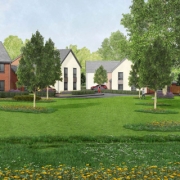A development of 160 new homes in Milton Keynes which is to be built using faster modern methods of construction has been given the green light.
Bellway will deliver a mix of modular and timber frame houses at Tattenhoe Park as part of a pilot project being led by Homes England.
The developer has been selected to deliver the fourth phase of homes at Tattenhoe Park, a landmark extension to the town, and its plans have since approved by Milton Keynes Council in October.
Bellway’s development will be located in the south-western part of the wider site, close to Priory Rise School. Construction work is due to get underway in April 2022 with the first homes set to be completed by August 2022.
Phase four at Tattenhoe Park will provide 112 properties for private ownership and 48 affordable homes for rent or shared ownership, as well as public open space and new pedestrian and cycle links.
There will be a mix of one and two-bedroom apartments, one and two-bedroom maisonettes, and two to four-bedroom houses.
The 40 modular homes will be built off site in a factory, while the other 120 properties will be constructed using timber frames and panels in place of traditional breeze blocks. Adopting these methods will enable the homes to be delivered at a faster pace than those built using more traditional techniques.
Paul Smits, Managing Director of Bellway Northern Home Counties, said: “This is a hugely significant development not only for Bellway and Milton Keynes, but also for housebuilding in this country. Phase four at Tattenhoe Park is the first Bellway development to include modular homes. It will deliver much-needed new housing for the town, and it is one of a select group of developments chosen by Homes England for its pilot scheme.
“The modern methods of construction we are using at Tattenhoe Park have the potential to transform the way new homes are delivered in this country. We are pleased to be working with Homes England on this exciting project to help accelerate the supply of new homes in high-demand areas.
“The off-site manufacturing process eradicates weather-related delays, which means we can speed up construction while maintaining the high quality that Bellway achieves as a five-star housebuilder.
“We look forward to starting work on the site and to releasing the first homes onto the market in Spring 2022.”
Outline planning permission is already in place for up to 1,310 homes at Tattenhoe Park, a new neighbourhood which is being created on the southern edge of Milton Keynes.



